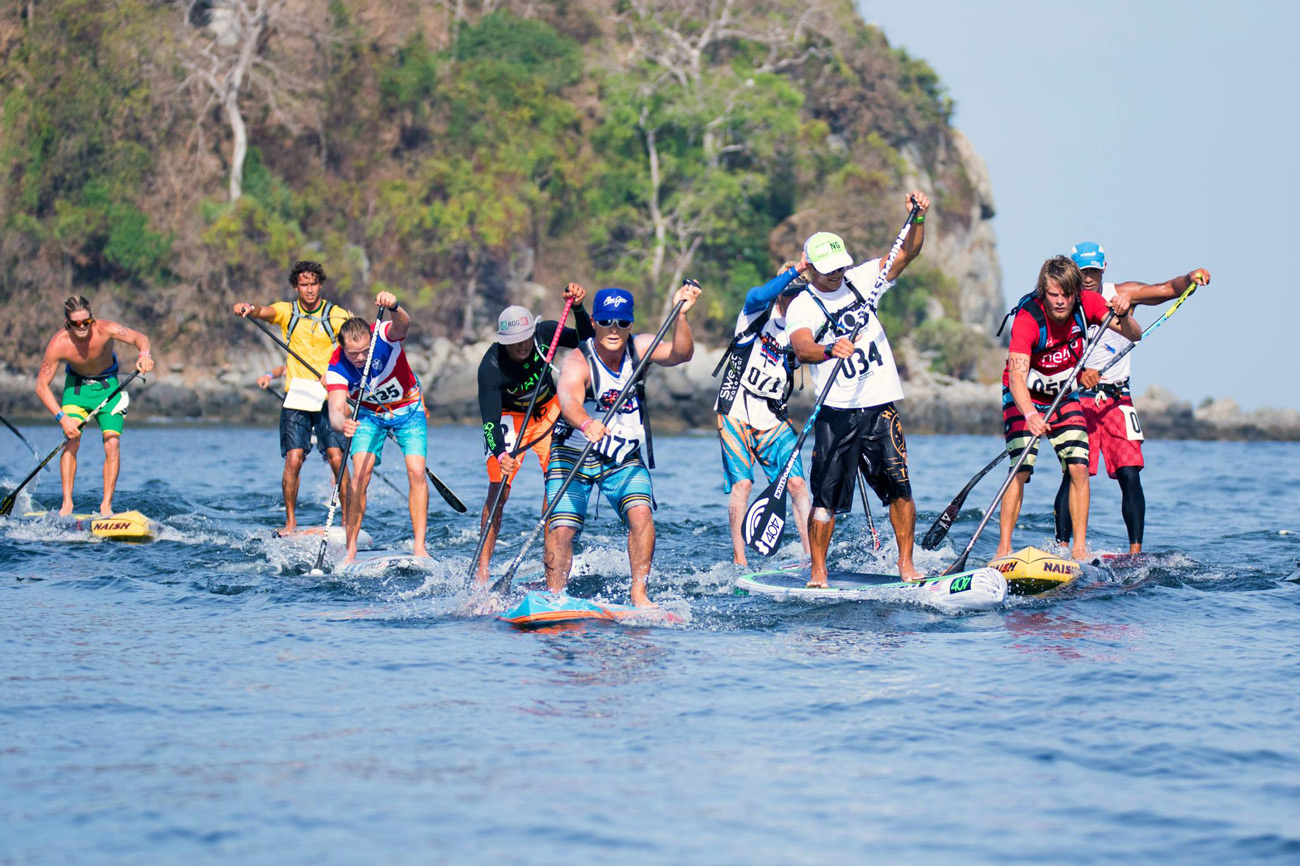
Mid-Year World Rankings: Travis Grant Is Number One (And There’s A Flaw In The System)
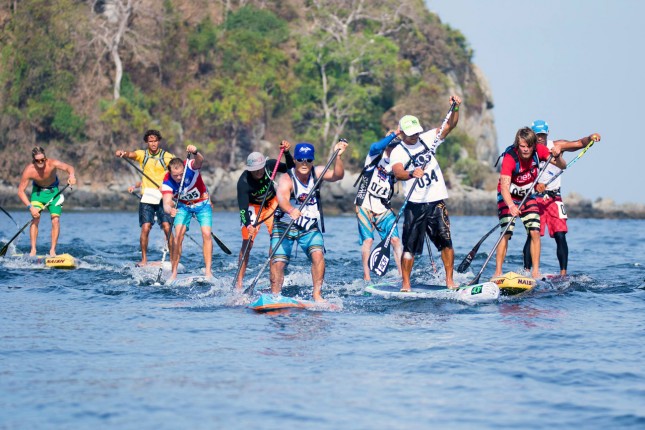
The ISA Worlds in Mexico produced some of the biggest and best racing of the year so far (photo: ISA)
And just like that, it’s August.
This year has flown by. Seems like only yesterday we were getting excited about the first major race of the year, the Carolina Cup. That was four months ago.
We’re now halfway through the international stand up paddling “season,” which loosely runs from April to October (with a couple of outposts in December). Carolina, OluKai, the Worlds, the Euro Tour, Payette and Molokai have already been run and won, while we’ve still got the Gorge Paddle Challenge, Pacific Paddle Games and a few World Series races to look forward to.
So because we’re halfway through the year, I thought it’d be a good time to analyse the best paddlers of 2015 so far.
The world of stand up paddling moves so quickly that it can be hard keep up with who’s in form, who’s firing and who’s failing. That’s why I spent the best part of two years developing the SUP Racer World Rankings. I hope it gives you a window into this awesome sport of ours, and perhaps brings some cohesion to the chaotic and very fragmented nature of the international race scene.
But while I created this system myself, I’m not afraid to admit it has a few flaws, a couple of which I’ll address today. I think it’s a good system in general, but all systems need to continue to evolve and improve, otherwise they’ll eventually become redundant.
The first flaw in the rankings is clear: The SUP Racer World Rankings are based on a rolling 12 month time frame, similar to how sports such as tennis produce their world rankings. I felt this was the best way to reward consistent athletic performance over an extended period, and also not have just two or three big events completely dominating the rankings.
However one issue with a rolling 12 month system is that it doesn’t accurately reflect who’s in the best form so far this season, at least not until late in the year. Most of the big races in 2014 were stacked in the second half of the year, which means high-scoring events such as the 2014 Battle of the Paddle, 2014 Gorge Paddle Challenge and 2014 World Series Finals are still influencing the current Men’s Top 100 and Women’s Top 50 Leaderboards.
That’s part of the reason why Travis Grant is ranked 4th in the world despite a stellar run of results the past few months. Travis is clearly the in-form paddler of 2015, however he wasn’t the in-form paddler of late 2014.
So to give you a more accurate idea of who’s in the best race form right now, today I want to present you with a hypothetical “Mid-Year World Rankings.”
(Heads up: you can jump straight to the the Mid-Year Leaderboards if you want to skip my ramblings).
[notdevice] [/notdevice]
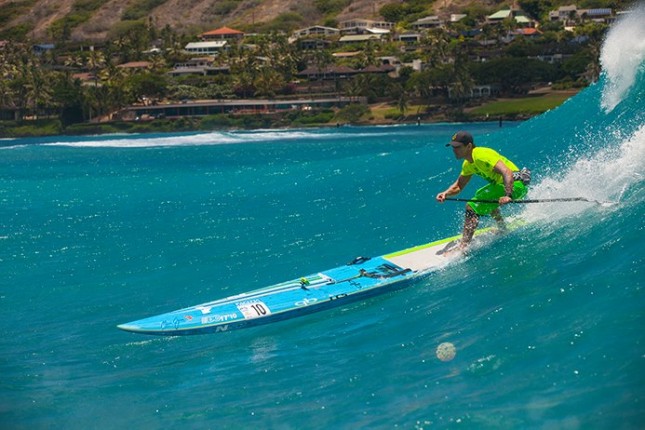
Travis Grant and “that” wave at the end of the Molokai crossing (photo: Dana Edmunds/danafoto.com)
I doubt I’ll ever change the 12 month time frame of the main World Rankings, but perhaps I’ll do a few of these “mid season” updates to give you a picture of who’s in the best short term form. I think the leaderboard below is a really cool way to look at the multi-layered international race season, and to reveal who have been the standouts, the big movers and the big sliders of season 2015 so far.
I believe these Mid-Year World Rankings give due credit to the best paddlers in the world right now, while also highlighting some of the dark horses that were still unknown last year but have started 2015 with a bang.
These rankings also give an indication of how the Top 100/Top 50 leaderboards may look at the end of season 2015. There are still a LOT of points up for grabs, with next weekend’s Gorge Paddle Challenge and October’s Pacific Paddle Games likely to be two of the three highest scoring events of the year (Carolina being the other), but this should give you an early peek at the end of season charts.
You can check out the hypothetical leaderboard for the Top 30 Men and Top 15 Women below. But before we get to that…
The second problem with my World Rankings system is that the Race Index algorithm fails to adequately reward certain events, specifically the “specialty races” like Molokai 2 Oahu and the Payette River Games. These kind of races are very important to our sport. They have a very significant impact on the racing community and are extremely difficult to win, however they don’t always attract the same depth of elite competition as the other majors.
The Race Index score goes from 0-100% and is calculated based on how many top ranked paddlers are competing. All men that are ranked in the top 50 (and all women ranked in the top 30) add a specific weighting to the Race Index score. The higher a paddler’s ranking, the more weighting they contribute. The score is based on whoever starts a race, not who finishes (so in the case of Molokai, all of the top paddlers that retired mid-channel still counted for the event’s Race Index score).
Every race in the world is eligible for the World Rankings, however only those that attract a “minimum level of elite competition” (15.0% or more on the Race Index) are counted. You can check out the full Race Index to see which events are currently counting, and for how much.
[notdevice] [/notdevice]
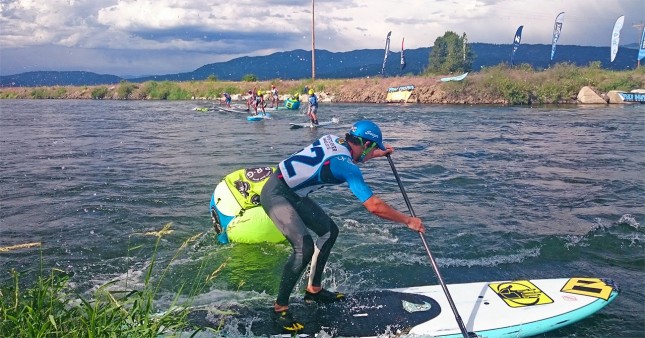
Mo Freitas’ dominance of the big Payette River Games was under-rewarded (photo: SUP Racer)
While I believe my Race Index formula provides an accurate summary of the big international races most of the time, it fails some of the big ones, with Payette and Molokai being two clear examples this year. That’s because my algorithm doesn’t factor in the importance, significance, prestige or difficulty of an event, it only looks at the elite level of competition.
I’ve always known this was an issue, however it’s become even more obvious following the relatively low scores from those two big races. Payette and Molokai tick all the boxes of “importance” “significance” “prestige” and “difficulty” yet they both scored relatively low on the Race Index, at least on the men’s side.
And that’s just not right.
It doesn’t recognise these events’ contribution to the sport, while more importantly it fails to reward the top performing athletes who excel in these challenging events. Travis Grant (Molokai winner), Sonni Honscheid (Molokai winner) and Mo Freitas (Payette winner) are three paddlers who should have more points than they do right now.
This isn’t a critical flaw in the system, but it is a problem. For the most part I think the Index is still a very accurate look at the big races in our sport. There’s a lot of science, maths and numbers going into the Race Index score of each event, and therefore how the Men’s Top 100 and Women’s Top 50 Leaderboards are produced. But this issue is still an issue, and I think I know how it can be fixed. I’ll continue rambling on about that down below, but for now let’s look at the hypothetical “mid year” leaderboards and see who’s in form right now.
Who Are The Best Paddlers Of 2015 (So Far…)?
If I had to pick the best half a dozen male paddlers off the top of my head, based on results from 2015 so far, I’d say: Travis Grant, Connor Baxter, Danny Ching, Titouan Puyo, Kai Lenny and Mo Freitas.
In that order.
Georges Cronsteadt showed world-beating form in Carolina, however that’s his only big result for the year.
As you’ll see below, my top four picks – Travis, Connor, Danny and Titou – are indeed holding down 1st through 4th on the Mid-Year World Rankings. And in that exact order.
The ranking formula seems to be doing a good job so far.
However there are a few caveats: Travis Grant should have a bigger lead than he does. Number two Connor Baxter has been in great form, winning OluKai, the Worlds and the Lost Mills (three of the biggest races of the year), however I believe Travis has the clear edge at the moment, having won the two most important events on the calendar so far: Carolina and Molokai. Trav is indeed holding down the world number one position on the mid-season charts, however only by the absolute narrowest of margins. If Molokai had have scored the Race Index percentage it deserved, the Aussie would have the lead he deserves.
[notdevice] [/notdevice]
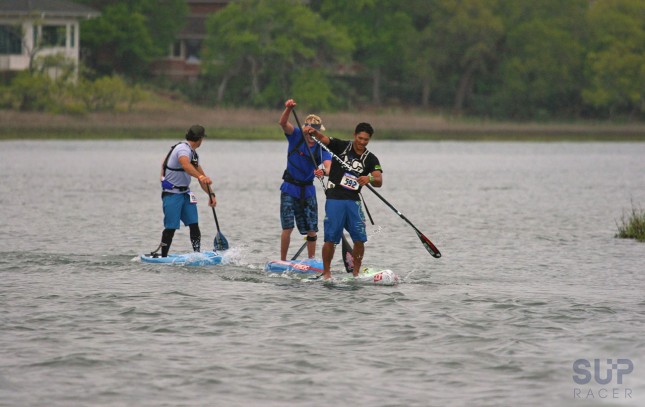
Travis Grant looks around and sees daylight as he, Danny and Connor control the race (photo: Chris McQuiston for SUP Racer)
Some have said that Travis should be higher on the overall 12 month World Rankings as well. That’s easy to explain though: The system is still counting big events from August-December 2014, such as the Gorge, the Battle of the Paddle and the World Series events in Huntington and Turtle Bay, i.e. events where guys like Connor, Kai and Danny picked up a bounty of points. As I said earlier, Travis has been the in-form paddler of early 2015, but he wasn’t the in-form paddler of late 2014. By the end of the year things will even out as those 2014 results get dropped from the system one by one.
Either way, Travis Grant is ranked world number one on the leaderboard below, and I think that’s where he deserves to be right now.
The other two guys I’d put in the top half dozen “in form” paddlers are Kai Lenny and Mo Freitas. Kai is ranked 12th Mid-Year but that’s easy to explain as well: He’s only raced twice this year (Barcelona and Molokai). If you averaged out Kai’s points from those two events and gave him a third result, he’d move straight up into 5th place, which is exactly where I think he deserves to be.
So things are looking very accurate so far, with the world’s current top five paddlers all getting the virtual leaderboard positions they deserve. By the end of the season, the main World Rankings will probably reflect that as well. If Travis continues his world-beating form, he’ll definitely be world number one by December (and he could reach it as early as next weekend in the Gorge).
However Mo Freitas’ world ranking is bothering me. His current World Ranking is #6, which is exactly where he should be right now, however his Mid-Year World Ranking is all the way down at 12th, which is strange because Mo’s in career best form this year.
Mo has had a stellar year, finishing second to Connor Baxter at the ISA Worlds before taking out one of the single biggest (and easily the most exciting) races of the year: The Payette River Games. Unfortunately for Mo (and Payette), the Race Index algorithm totally underscored that event. The reason is simple: Mo was the only top 10 paddler that competed, which robbed the event of a sizeable chunk of its Race Index scoring potential. It scored 22.0% on the men’s side but seemed more like a 50%+ race.
But just because there was only one of the top 10 guys on show doesn’t mean it wasn’t a hard race to win. In fact I’d say Payette was not only one of the “most significant” races of the year, it was also one of the hardest. Conditions and courses were extremely challenging, while there was a big and very talented men’s field on show. All of which makes Mo’s clean sweep of the weekend one of the best performances of 2015 in my opinion.
Another reason Payette picked up an unusually low score is that a lot of the river specialists don’t compete (or don’t compete well) in the other major races, which robs them of a high world ranking and means they don’t contribute to Payette’s Race Index score, despite being some of the best paddlers in the event.
The same thing can be said for Molokai: It’s a very significant and prestigious event, and is extremely difficult to win, but still scores a relatively low percentage on the Race Index.
The system can be easily tweaked to correct this anomaly, and in 2016 it most likely will be. I’ll talk about the possible solution below, but for now let’s look at the numbers.
The overall SUP Racer World Rankings are based on an athlete’s best five results from the past 12 months. However because these hypothetical “Mid-Year” World Rankings are only halfway through the season, I’ve cut the “best five” requirement down to best three results.
Mid = Mid-year world ranking
WR = Current world ranking (based on past 12 months)
+/- change between current and mid-year world ranking
Points = combined points from best three results
Races = total races between January and July (only best three results count)
| Mid | WR | +/- | Name | Points | Races | Nation | Brand |
|---|---|---|---|---|---|---|---|
| 1 | 4 | +3 | Travis Grant | 118.88 | 5 | Australia | NSP |
| 2 | 1 | -1 | Connor Baxter | 118.50 | 13 | Hawaii | Starboard |
| 3 | 2 | -1 | Danny Ching | 111.63 | 5 | USA | 404 |
| 4 | 8 | +4 | Titouan Puyo | 93.88 | 8 | France | Starboard |
| 5 | 13 | +8 | Trevor Tunnington | 74.60 | 4 | New Zealand | Starboard |
| 6 | 7 | +1 | Georges Cronsteadt | 69.49 | 4 | Tahiti | SIC |
| 7 | 10 | +3 | Bicho Jimenez | 63.84 | 9 | Mexico | Rogue |
| 8 | 9 | +1 | Casper Steinfath | 61.16 | 7 | Denmark | Naish |
| 9 | 15 | +6 | Arthur Arutkin | 60.20 | 5 | France | Fanatic |
| 10 | 5 | -5 | Jake Jensen | 55.53 | 9 | Australia | Fanatic |
| 11 | 6 | -5 | Mo Freitas | 54.93 | 5 | Hawaii | Focus |
| 12 | 3 | -9 | Kai Lenny | 52.88 | 2 | Hawaii | Naish |
| 13 | 18 | +5 | Leonard Nika | 52.68 | 10 | Italy | Starboard |
| 14 | 11 | -3 | Zane Schweitzer | 50.33 | 5 | Hawaii | Starboard |
| 15 | 21 | +6 | Matt Nottage | 44.26 | 6 | Australia | Starboard |
| 16 | 19 | +3 | Vinnicius Martins | 43.49 | 7 | Brazil | JP Australia |
| 17 | 17 | - | Kelly Margetts | 42.00 | 6 | Australia | Lahui Kai |
| 18 | 24 | +6 | Paolo Marconi | 38.24 | 7 | Italy | RRD |
| 19 | 26 | +7 | Travis Baptiste | 35.03 | 3 | Hawaii | 404 |
| 20 | 14 | -6 | Lincoln Dews | 32.95 | 3 | Australia | Lahui Kai |
| 21 | 20 | -1 | Chase Kosterlitz | 31.92 | 5 | USA | BIC |
| 22 | 23 | +1 | Fernando Stalla | 31.43 | 9 | Mexico | Rogue |
| 23 | 16 | -7 | Eric Terrien | 30.29 | 7 | France | BIC |
| 24 | 12 | -12 | Beau O'Brian | 30.21 | 8 | Australia | Starboard |
| 25 | 32 | +7 | James Casey | 28.90 | 6 | Australia | JP Australia |
| 26 | 30 | +4 | Niuhiti Buillard | 28.79 | 6 | Tahiti | 404 |
| 27 | 29 | +2 | Paul Jackson | 27.70 | 8 | New Zealand | free agent |
| 28 | 22 | -6 | Slater Trout | 26.95 | 3 | USA | Infinity |
| 29 | 33 | +4 | Roman Frejo | 26.89 | 5 | Spain | Starboard |
| 30 | 42 | +12 | Jeremy Riggs | 26.87 | 3 | Hawaii | SIC |
Where the top paddlers earned their points:
Travis Grant
1st: Carolina Cup (63.50 points)
1st: Molokai 2 Oahu (31.00)
2nd: OluKai (24.38)
Connor Baxter
1st: Lost Mills (43.50)
1st: Barcelona (39.50)
1st: ISA Worlds Course Race (35.50)
Danny Ching
2nd: Carolina Cup (47.63)
1st: ISA Worlds Distance Race (43.00)
1st: Race The Lake of the Sky 14 Miler (21.00)
Titouan Puyo
2nd: Lost Mills (32.63)
4th: Carolina Cup (31.75)
1st: Bilbao (29.50)
Travis Grant finally gets the recognition he deserves on the World Rankings, even if in a purely hypothetical setting. The Aussie is becoming something of a legend in the paddling world, having won the two biggest races of 2015 so far, Carolina and Molokai, to sit alongside his Battle of the Paddle and ISA World Championship titles from previous years. Helps that Trav is probably the nicest and most humble guy you’ll ever meet off the water as well. A champion all round.
Trav famously conquered the brutal Ka’iwi Channel to win this year’s Molokai, his second M2O title in three years. Travis, paddling his Magic Molokai Board finished 16 minutes ahead of the runner-up, who had far more logistical and financial support but couldn’t match Trav’s pure determination and raw talent.
[notdevice] [/notdevice]
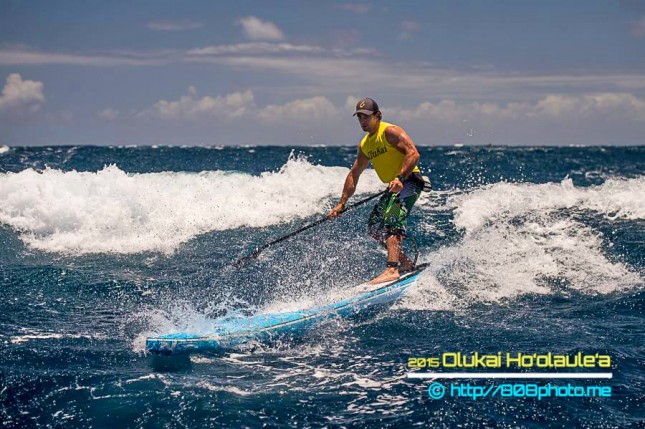
Travis Grant at OluKai, where he finished runner-up in one of the biggest races of the year (photo: 808photo.me)
The long-time world number one, Connor Baxter, has had a rollercoaster season. There have been wins in some of the biggest races of the year, including the ISA Worlds Course Race (35.5%), the Lost Mills (43.5%) and OluKai (32.5%). However he failed to defend his Molokai title, retiring hurt mid-channel, and had a similarly disappointing finish in Carolina, coming home 5th after being in the lead trio with Travis and Danny for much of the race.
While he’s second on the Mid-Year charts, Connor still holds the title of world number one on the overall World Rankings. However that position is in doubt too, with Connor needing a massive result at the Gorge Paddle Challenge to hold on. Connor swept the event in Hood River last year, which means he’ll be dropping a huge bag of points next weekend and replacing them with whatever result he gets this year. Considering all of the world’s top eight ranked men will be in Oregon, there’s going to be some serious competition for the young Maui superstar. I wouldn’t be surprised if we see a new world number one next week.
Earlier this season, in the space of just three or four minutes, Danny Ching put in one of the strongest bursts of paddling I’ve ever seen. After local hero Bicho Jimenez broke the field at the start of the final lap in Sayulita, the other dozen odd contenders seemed spent. None of them could close the gap on Bicho, with the home crowd cheering him on to a bigger and bigger lead. But then Danny decided to take matters into his own hands, and, like a Tour de France champion closing the gap on the breakaways up a steep Pyrenees mountain, caught Bicho within minutes. From there it was a two-man dogfight, but Danny proved too strong and took yet another gold medal for the dominant Team USA.
[notdevice] [/notdevice]
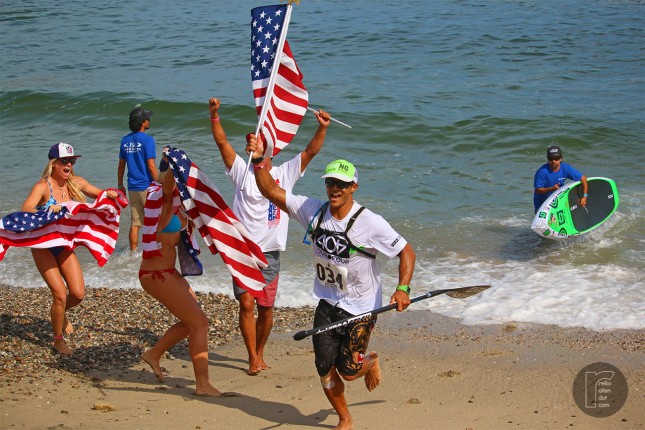
Danny Ching claims gold for the stars & stripes in Mexico (photo: Reiko Allen)
That was the highlight of Danny’s year though. He faded to Travis in Carolina after being in the box seat with a mile to go, and couldn’t muster anything big at OluKai. Danny is also without a solid third result so far this season, so he’s got some work to do in the back half. Danny is currently holding big points from the Battle of the Paddle (3rd in the elite race and 1st in the distance), which will expire in early October and send his points sliding. Though before then, if he scores a big result at the Gorge this weekend Danny could actually move into the overall world number one position ahead of Connor, Kai and Travis. Either way, I think the Gorge is going to have a big impact on the rankings…
Titouan Puyo is perhaps the most significant mover on the Mid-Year World Rankings. After a top four finish at Carolina, another medal at the Worlds and a string of big results in Europe – where he probably should have won the Euro Tour (he finished a narrow second to Connor) – Titou is now mixing it with the very best stand up paddlers on the planet.
That’s quite a meteoric rise for a paddler who was a complete unknown on the racing scene less than 24 months ago. But he’s not done rising yet…
I genuinely believe Titou will be the best paddler in the world in another year or two. He’s been stand up paddling less than three years and seems to get faster with every race. He’s also about nine years younger than the likes of Travis and Danny, and only a year or two older than Connor and Kai. Titou has plenty of time to show his true potential, though I daresay it’ll come about sooner rather than later.
Just like Danny, Travis and Georges, Titou has an outrigger background (just last week he won the national titles in New Caledonia, one of the strongest outrigger nations on the planet), which helps explain his flawless technique. Seriously if you look at Travis and Titou when they’re racing, they don’t look like they’re even trying.
[notdevice] [/notdevice]
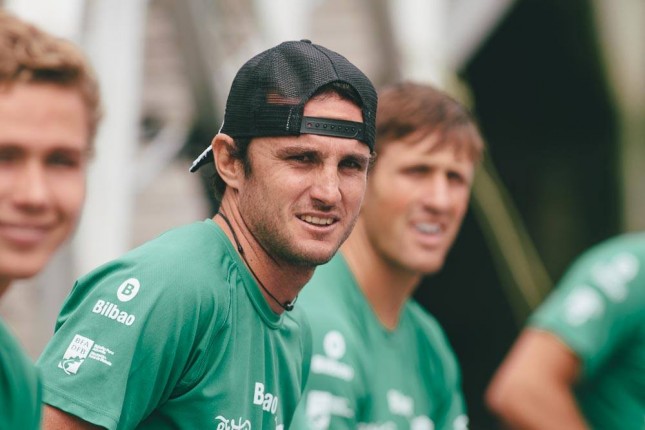
Titouan Puyo: The smiling assassin (photo: BWaters)
Other stand out performers on the Mid-Year World Rankings include Trevor Tunnington, who had a couple of very big results at the Lost Mills week (the second highest scoring event of the year so far at 43.5%). The young Kiwi, who’s based in Australia, sits 5th on the Mid-Year charts, edging out a dozen names that are far better known on the international scene. If Trev hits California in October and lands a few big results, he’ll be well inside the overall top 10 by year’s end.
Georges Cronsteadt is still flying the flag for Tahiti, though his current ranking is largely thanks to a third place at the massive Carolina Cup (a 63.5% race). He’s got some work to do in the Gorge, where he’s holding a 4th in the course race and 2nd in the Double Downwinder. He’ll need similarly big results next weekend to avoid moving backwards.
The hero of Mexico, Bicho Jimenez, is definitely in form right now, sitting at 7th on the hypothetical mid-season rankings. Bicho famously broke the field during the distance race at the ISA Worlds, which were held in his hometown of Sayulita. The humble champion was eventually reeled in by the unstoppable force of Danny Ching, however he still left a big impression on the racing community. If he can back up his Worlds performance at the PPGs in October, Bicho could be knocking on the door of the top five.
The Danish Viking, Casper Steinfath, has proven just how consistent he is, sitting at #7 in the world this season to almost identically match his overall #8 ranking.
Another Euro boy, Arthur Arutkin, has enjoyed a stellar summer and is finally showing his true potential. If Arthur continues that form into California, he’ll be a good bet to finish the year ranked inside the world’s top 10.
[notdevice] [/notdevice]
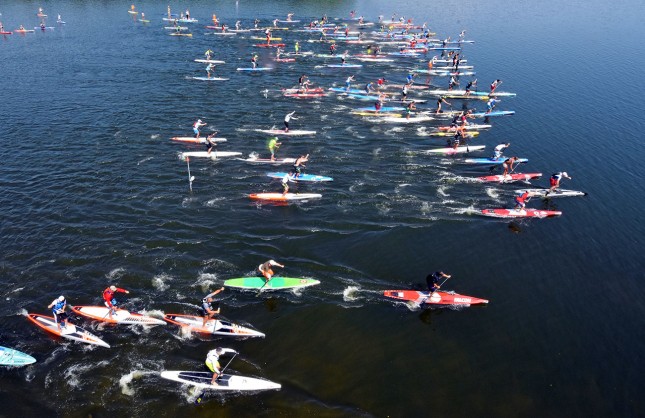
Europe’s most prestigious race, the Lost Mills, had a big impact on the World Rankings (photo: Ernstfried Prade)
Aussie Jake Jensen rounds out the Mid-Year Top 10, however his differential of -5 shows that 2015 hasn’t been nearly as good as the back half of 2014, where he finished runner-up at the Battle of the Paddle and had a big result in Huntington. Jakey boy will need some similarly big results over the next eight weeks, otherwise he risks slipping outside the top 10 altogether by year’s end.
Elsewhere in the Top 20 we can see other big movers and a handful of new faces. Australia’s new dark horse is Matt Nottage, who enjoyed a massive Downwind Month in Hawaii. One of the new heroes of Europe is Italy’s Leonard Nika, who raced more than anyone this summer to gain a virtual world ranking of 13th. Another of the big movers in Europe this summer was Leo’s compatriot Paolo Marconi, who topped off a great summer by winning his home Euro Tour event, the Adriatic Crown. Paolo and Leo are leading an Italian assault right now, with the nation moving up to become the clear #2 nation in Europe (behind long-time leaders France).
The always-smiling Vinnicius Martins is carrying the hopes of Brazil on his shoulders, and doing quite well despite the weighty task. Vinni is 19th overall and 16th on the Mid-Year Leaderboard, and he’d be even higher if Molokai got the Race Index score it deserved. The Brazilian was the heartbreak story of Molokai 2014, retiring with a broken rudder after being in contention for a top five finish. He returned fitter, faster and more determined than ever this year, storming home to finish 4th in what was arguably the toughest Molokai crossing of all time.
I’ve capped these Mid-Year World Rankings at the Top 30 because we’ve only had so many big races, which meant that beyond thirty, the leaderboard became too diluted and inaccurate. It’s even harder to judge the women, with the top ladies rarely competing against each other, so I capped that at 15 to provide an accurate-as-possible look at the season so far.
Mid-Year World Rankings: Top 15 Women
Mid = Mid-year world ranking
WR = Current world ranking (based on past 12 months)
+/- change between current and mid-year world ranking
Points = combined points from best three results
Races = total races between January and July (only best three results count)
| Mid | WR | +/- | Name | Points | Races | Nation | Brand |
|---|---|---|---|---|---|---|---|
| 1 | 1 | - | Annabel Anderson | 100.88 | 7 | New Zealand | Lahui Kai |
| 2 | 5 | +3 | Sonni Hönscheid | 99.00 | 9 | Germany | SIC |
| 3 | 2 | -1 | Lina Augaitis | 81.30 | 7 | Canada | SIC |
| 4 | 3 | -1 | Candice Appleby | 73.25 | 6 | USA | Bark |
| 5 | 4 | -1 | Fiona Wylde | 62.55 | 6 | USA | Starboard |
| 6 | 7 | +1 | Terrene Black | 61.53 | 5 | Australia | ECS |
| 7 | 6 | -1 | Angela Jackson | 61.28 | 7 | Australia | One |
| 8 | 8 | - | Shae Foudy | 55.20 | 5 | USA | Riviera |
| 9 | 15 | +6 | Penelope Strickland | 48.21 | 3 | New Zealand | free agent |
| 10 | 17 | +7 | Rebecca Giddens | 45.00 | 2 | USA | ULI |
| 11 | 9 | -2 | Andrea Moller | 44.90 | 2 | Brazil | SIC |
| 12 | 10 | -2 | Celine Guesdon | 41.85 | 6 | France | BIC |
| 13 | 20 | +7 | Manca Notar | 41.85 | 3 | Slovenia | Naish |
| 14 | 14 | - | Rachel Bruntsch | 33.88 | 4 | Hawaii | Rogue |
| 15 | 12 | -3 | Shelby Taylor | 33.85 | 8 | USA | Riviera |
Where the top paddlers earned their points:
Annabel Anderson
1st Carolina (48.00)
1st Santa Monica Pier Distance (27.00)
2nd Molokai (25.88)
Sonni Hönscheid
2nd Carolina (36.00)
1st Molokai (34.50)
2nd OluKai (28.50)
Lina Augaitis
1st Lost Mills TT (31.00)
3rd Carolina (28.80)
1st Bilbao (21.50)
Candice Appleby
1st ISA Worlds Course (28.50)
1st ISA Worlds Distance (24.50)
1st Barcelona (20.00)
[notdevice] [/notdevice]
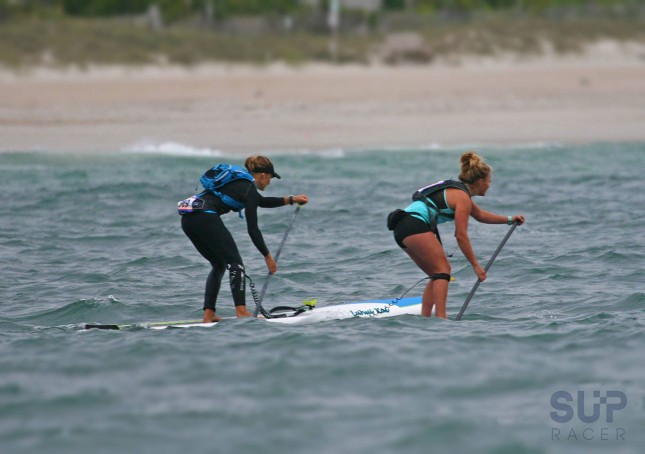
Annabel Anderson and Fiona Wylde at the Carolina Cup (photo: Chris McQuiston for SUP Racer)
The biggest mover on the Mid-Year World Rankings vs. the actual World Rankings is Sonni Honscheid, with the German enjoying career best form between April and July. Sonni took second behind Annabel at the biggest race of the year, Carolina, before running away with the Euro Tour title. The peak came in late July, with Sonni defending her Molokai crown in a brutal test of mental and physical strength.
Though as with Travis, Sonni’s victory wasn’t rewarded nearly well enough, and if Molokai received it’s due recognition on the Race Index, she’d probably be the mid-year world number one.
But it’s really no surprise to see Annabel Anderson on top. Despite a lighter race schedule than most of her rivals, Annabel is still clearly the fittest and fastest woman in the world. It’ll be interesting to see how she performs in the Gorge next weekend, where Annabel faces the same predicament as Connor (after sweeping the event in 2014, these two will have to make it another clean sweep just to tread water). Though really, you’d be a brave person to ever bet against the Kiwi. I expect Annabel to make it another clean sweep up in the Gorge, and I expect her to be the year end world number one.
[notdevice] [/notdevice]
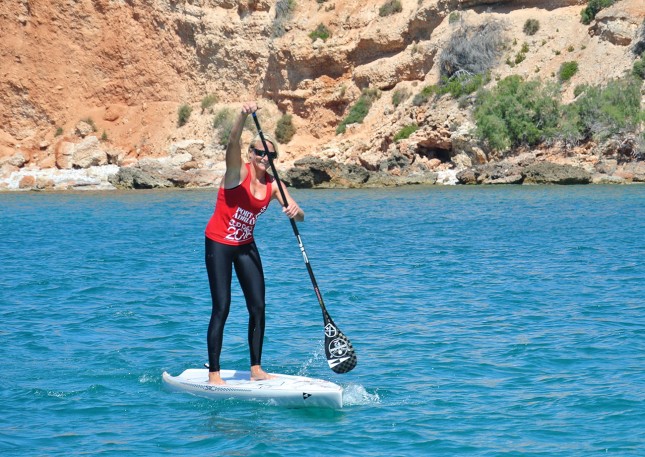
Sonni Honscheid at the Port Adriano SUP Race on Mallorca, Week 1 of the Euro Tour (photo: Jose Maria Sanchez)
Canada’s Lina Augaitis finds herself in a rather odd position. She’s the third best performing woman in the world at the mid-point of the season, however her season is already over. Lina is five months pregnant and won’t be on another podium for a good year or so. That means that over the next few months, as the 2014 Gorge and Battle of the Paddle results are dropped from the system, Lina will begin her inevitable slide out of the rankings.
There’s a very tight group from 5th to 7th, with Fiona Wylde, Terrene Black and Angie Jackson sitting on near-identical points. All three of these talented women will be on show in the Gorge next weekend, where one of them could make their move to solidify a top five spot at the end of the season.
For the most part, the women’s Mid-Year World Rankings are closer to the overall World Rankings than the men’s. Though two big +/- movers are Penelope Strickland, who had great results in Hawaii and Mexico, and Rebecca Giddens, who made it a clean sweep of the Payette River Games (which, unlike the men’s event, scored highly on the women’s Race Index).
Another Mid-Year bolter is young Manca Notar from Slovenia. Despite injury and exams keeping her away from some of the big events earlier in the season, Manca begun showing her potential in July and will be well placed to make an assault on the overall Top 10 by year’s end.
[notdevice] [/notdevice]
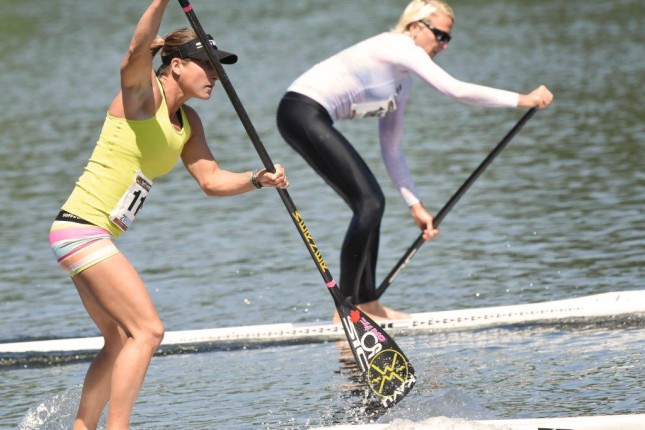
Sonni and Lina going head to head at the Lost Mills “Fastest Paddler On Earth” time trial (photo: Ernstfried Prade)
As with the men, we can expect the Naish Columbia Gorge Paddle Challenge to score very highly on the women’s Race Index next weekend. That means we’ll see a lot more changes ot the overall World Rankings in less than a week.
But for now, that’s how the season looks at the halfway mark.
I hope that gives you a good indication of who’s in form right now. And, if you’re feeling brave, there’s a nice long ramble about the “flaw in the system” down below… (grab a coffee if you intend on venturing any further).
How To Improve The SUP Racer World Rankings
As I’ve already made clear: I was disappointed to see Molokai only fetch 31.0% on the men’s Race Index, while I was even more disappointed to see Payette only score 22.0%.
Both events deserved far more recognition than that.
I’ve explained the problem above but just to refresh: The Race Index algorithm only factors in how many top ranked paddlers are competing, and the higher an athlete’s ranking, the greater weighting they contribute. However some races, particularly the specialty events like Molokai and Payette, don’t have an “elite level of competition” in line with their significance or prestige. However that doesn’t mean these races are any less difficult to win – Mo’s victory at Payette and Travis’ win at Molokai were probably the two biggest performances of the year so far – which means the Race Index score isn’t an accurate reflection in every case.
So how to fix it?
In short: It’s impossible to quantify “prestige” and “significance” with a purely mathematical, statistical formula, as I’ve been able to do with the “elite level of competition” criteria. The only solution is to manually assign added value to the races that are deemed significant, prestigious and therefore important to the world of international SUP racing.
The simple solution is to guarantee the biggest and best races a minimum score on the Race Index. So for example, Molokai and Payette could be “protected” with a minimum score of 50% or 60% or any other arbitrary number.
But therein lies the dilemma. How does one decide which races deserve more weighting? Who decides? And how much should each event score?
This idea of protecting key events with a minimum score is something I toyed with while creating the World Rankings system a couple of years ago. But up until last month I was very hesitant to introduce this “protected events” element to the system, as it would give certain races an “unnatural” score on the Race Index. I wanted the Race Index to be purely about the numbers.
I was also very cautious about trying to influence the international calendar too much. I wanted the World Rankings to be a simple “window” into the sport, rather than trying to dictate where international SUP racing should be headed.
But I feel that Molokai and Payette have highlighted the need for a tweak to the system. I would rather see a few slightly “unnatural” Race Index scores for certain key events, rather than having their contribution to the sport go under-appreciated.
Though I worry that giving my blessing to certain key races would be tantamount to “sanctioning” these events, something I want to avoid at all costs. The SUP Racer World Rankings, despite my own personal biases in favour for/against certain events, is designed to give the most accurate and unbiased look at the professional side of our sport. The numbers aren’t political or biased.
I also worry that protecting certain events would alter which races got the most attention from certain athletes. While several top paddlers don’t really care about their world ranking, many of them do, and increasingly it’s being used by brands to determine which riders are their star performers. Some athletes already plan their season around which races they’ll be able to get the most points at, and if I guaranteed minimums at certain events, that trend would surely increase.
And perhaps that would be a good thing. Or perhaps it wouldn’t. Perhaps it would reward the events that deserve the most support, or perhaps it would expose my personal biases and dilute the purity of the World Rankings system.
I’m not enthusiastic about having the SUP Racer World Rankings morph into an unofficial world tour, as some have suggested it should. We’ve already got enough “world champions” and “official” governing bodies in this sport. We don’t need more fragmentation. That’s the complete opposite of what the World Rankings were designed to provide.
I did experiment with “protected events” in Europe this summer, to help promote the Euro Tour (which I felt was key to the future success of the sport in Europe). However I only used a guaranteed 15.0%, the bare minimum Race Index score an event requires to qualify for the rankings system. This move had very little influence on the leaderboards. However if I extended this “protected events” practice to the key, international events, I’d have to use something like 50% or 75%, which would suddenly have a big impact on the leaderboards.
There is some precedent in sport for “protected events” in world rankings. Professional golf, which uses a system very similar to the SUP Racer World Rankings, where events are rated based on how many of the top ranked golfers show up. However there’s one key difference: The golfing “majors” have a guaranteed minimum score, which is almost always higher than what any other event can achieve. This makes them worth more points to the golfers and helps ensure they hold the highest prestige.
Perhaps this could work in SUP racing as well.
So what’s the answer?
For the remainder of the 2015 season, nothing will change. All races between now and December 31st will be ranked based on the existing Race Index algorithm.
However in 2016 I will, almost certainly, give “protected event” status to several key races. Which races, and how many points they deserve, is something I’ll have to figure out over the next few months.
I think the easiest answer is to just give the five “Majors” protected status and leave all other races to the natural forces of the marketplace. The majors are Carolina, Payette, Molokai, the Gorge and now the Pacific Paddle Games (which replaces the BOP). Perhaps they’re all worth at least 60%, and if they attract a higher level of competition (such as Carolina at 63.5%), they’d receive that higher score.
But if I only give my blessings to those five, what about the ISA Worlds? What about the Euro Tour, which includes Europe’s most prestigious race, the Lost Mills? What about the World Series? What about the “regional majors” in places like Australia, Japan and Brazil? Those five are all in the United States, which doesn’t reflect the international nature of the elite stand up paddling world.
Perhaps I could more strictly enforce the star ratings that I use on the Rogue Race Calendar, and then assign minimum points to the 4, 5 and 6 star events. All “regular” races could be given 1, 2 or 3 stars, while the “important” races would be 4, 5, or 6. A four star race may have a protected status of 20%, a 5 star may earn a minimum of 40 points and a six star be 60% (and all races could score higher, those numbers would just be the bare minimum). On top of that, any “regular” race, whether it be 1, 2 or 3 stars, could still qualify for the World Rankings if it surprises us with a strong level of elite competition (and therefore scores 15% or above on the Race Index).
I think this would be the fairest way, but then it perhaps becomes too confusing to follow. And I’d still have to decide which events deserve what star rating.
There’s no easy answer, but I am going to find the best possible answer before the end of the year. I’ll talk with the event organisers, the athletes and every other influential stakeholder to see what we should do. I know the SUP Racer World Rankings is only one tiny part of a much bigger ecosystem, but many people seem to believe it’s an important one, so I want to make sure it’s functioning as well as possible.
I really don’t want to create a world tour, but I do want to continue evolving the SUP Racer World Rankings so they’re the most accurate window into our sport. If SUP Racer has to put its hand through the window from time to time and slightly adjust things for the good of the sport, then that’s just the way it’ll have to be.
We’ll find out in a few months.
Until then, congratulations to Travis Grant and Annabel Anderson, your Mid-Year World Rankings number one athletes, and to all the other paddlers that have had such a fine season so far, and whose athletic abilities go a long way to keeping me in a job. See you at the Gorge.
P.S. If you actually did read all the way down to here, congratulations, you deserve a break. Go watch an awesome video on the SIC Showreel. Or better yet: Go grab your board & paddle and hit the water.
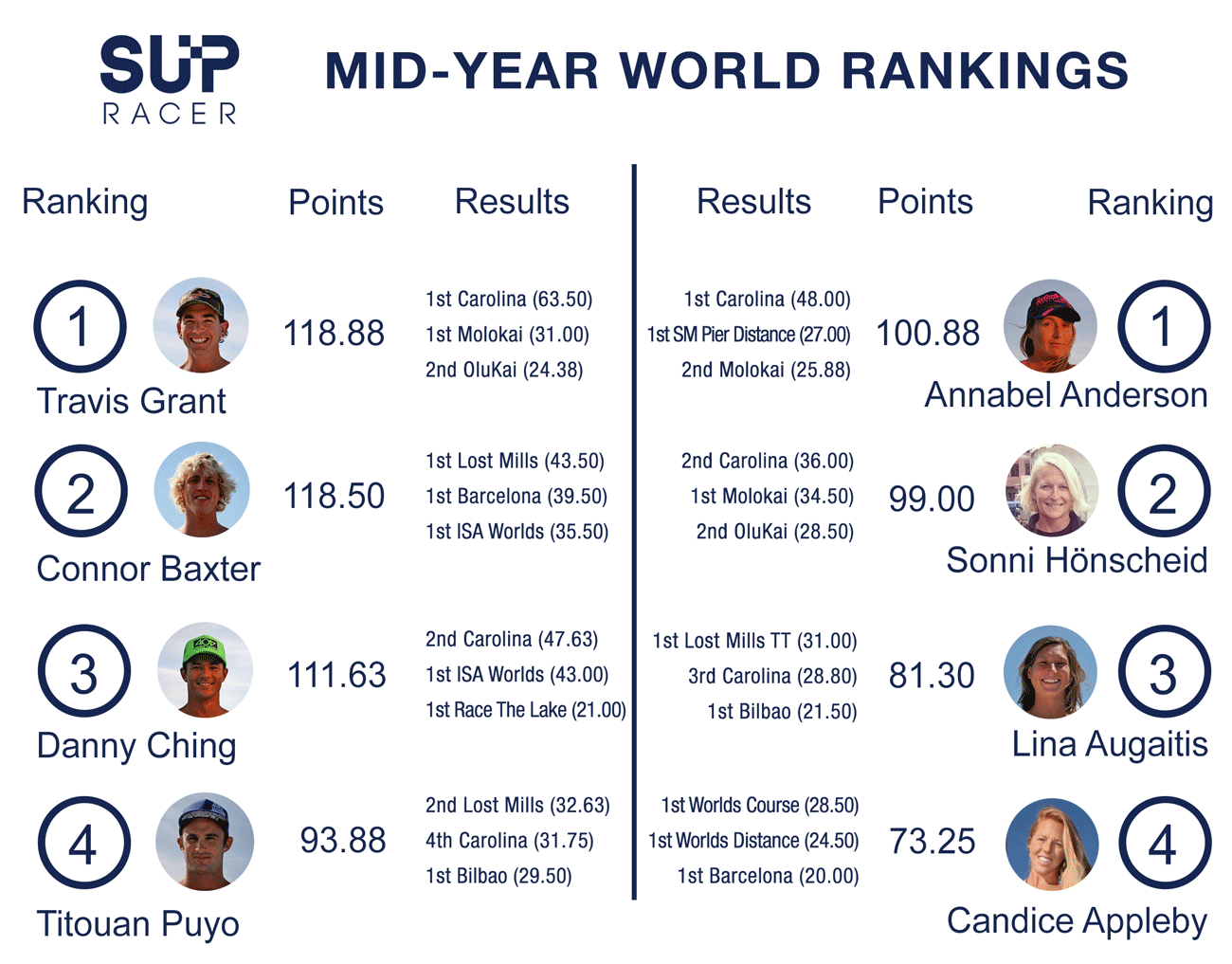



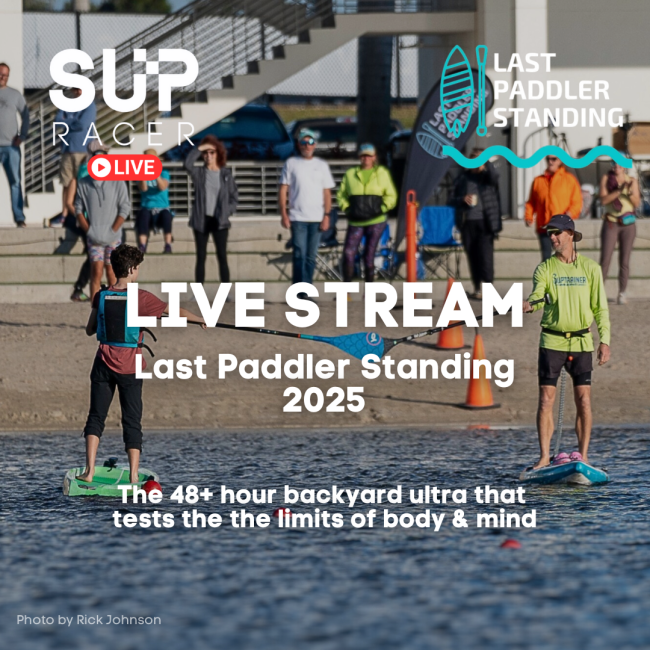
You must be logged in to post a comment.